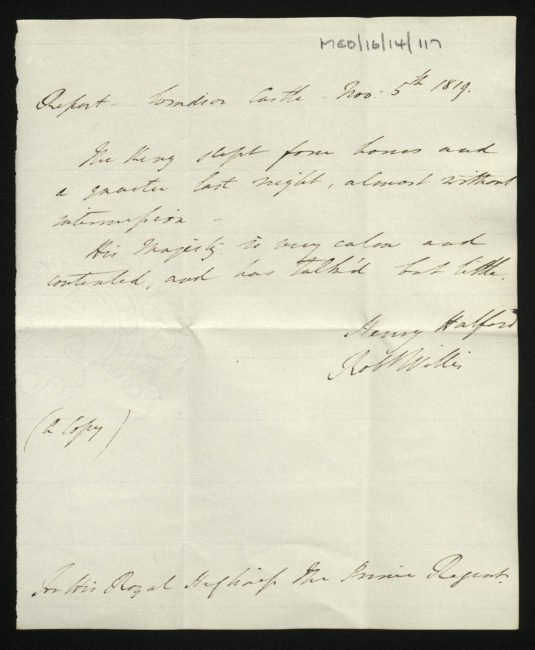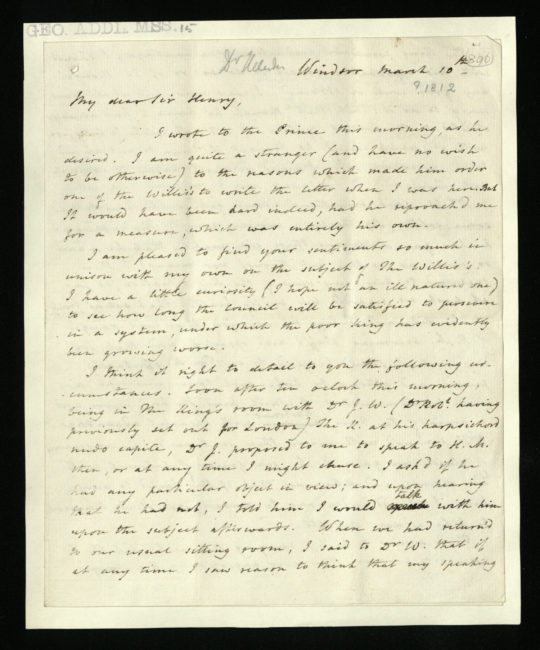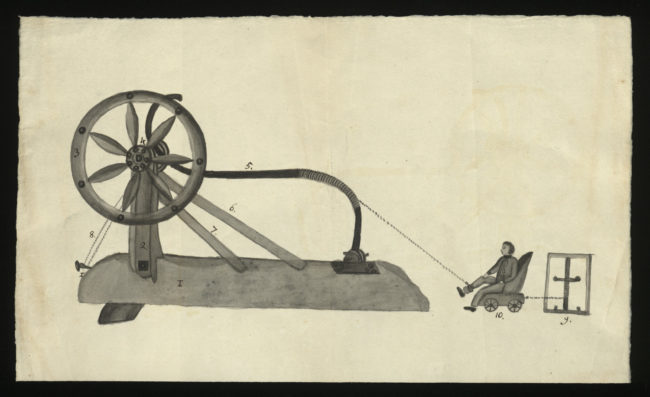Transcribe the Medical Papers of George III
In coordination with Georgian Papers Programme London event Mental Health and the Georgian World, the GPP transcription site, Transcribe Georgian Papers released three George III medical collections to transcribers.
In this post we highlight the three collections, and provide transcription tips –
George III medical papers
George III’s medical papers primarily cover the Regency era, in which health issues prevented him from fulfilling his duties as King. During this time, his eldest son, the Prince of Wales, ruled as Prince Regent. The Prince of Wales’ regency lasted from 1811 until his father’s death in 1820, when he inherited the throne and became George IV.[1]
George III’s physicians kept detailed records of his health during this time, giving researchers an intimate portrait of George III’s illness. The King’s physicians wrote daily letters to the Prince Regent to keep him updated on his father’s condition, noting the quality of his sleep, speech, and appetite. These letters, arranged chronologically, make up most of the medical papers.
GPP transcribers (you!) will find sets of letters grouped together in periods of one to four months, and many sets are over two hundred pages. So, there’s plenty of documents to transcribe!
Here are some useful tips for transcribing this collection:
- To become a transcriber, create an account.
- Familiarize yourself with the Core Guidelines or Tutorials , especially for spacing, line breaks, and indents.
- Review and select documents by clicking on a set to display the pages, and from there scroll through the pages to decide which ones you would like to transcribe.
- Documents are labeled as ‘medium’ in difficulty level, as the letters are written by a multitude of people and handwriting varies.
- ‘The Progress of the Symptoms of the King’s Illness,’ document, we recommend reviewing the guidelines for ‘notes’ in Advanced Guidelines.
- There are documents that contain multiple columns. We recommend using your best judgment to determine if these should be transcribed from left to right across the page or column by column.
See an example below of a physician’s report on George III’s health, written two hundred years ago today!

Report of George III’s health by Sir Henry Halford, 5 November 1819. MED16/14/70-184 Royal Archives/© Her Majesty Queen Elizabeth II 2019
Georgian manuscripts in the Royal Library on medical matters
This collection contains the journals of the Hon. Robert Fulke Greville, who first served as Equerry and then Groom of the Bedchamber to George III. A complement to the records kept by the King’s physicians, Fulke’s perspective captures the emotional toll of George III’s illness on the Royal Family. The handwriting is easy to read for most of these two volumes, some sections less so than others (like most of us, Fulke began each new volume with his neatest handwriting). Familiarity with our guidelines for underlining, additions, deletions, and images will be helpful in transcribing this document.
Two items of note:
- Fulke Greville’s journals have significant bleed-through of ink, which may make some portions more difficult to read.
- Journal Vol. 2 has two small pages on top of larger pages on pages 24 and 25. Consult our guidelines for Princess Augusta Sophia’s letters for instructions.
The collection also contains a description of, and instructions for, an electric medical device by Jacques Timmermans, written in French. Timmermans’ handwriting is very clear, but familiarity with our guidelines for marginal notes and images will be helpful in transcribing this document.
View and transcribe the Royal Library medical documents
Papers of Sir Henry Halford
This collection contains letters written by members of the Royal Family and fellow physicians to George III’s physician Sir Henry Halford, as well as the diary he kept during the King’s illness.
Because Halford’s papers contain letters from multiple people, the clarity of the handwriting is not consistent. Halford’s own handwriting earns a ‘Difficult’ rating from us! See ‘Transcribing Tips’ in the ‘Introduction to GPP Transcription’ in the Tutorial for helpful advice for when you get stuck.
View and transcribe the Halford documents.

Letter from Dr. William Heberden to Sir Henry Halford, 10 March 1812. GEO/ADD/15/896 Royal Archives/© Her Majesty Queen Elizabeth II 2019
The George III medical papers are an important collection of evidence for learning more about the later life of George III and the Regency era. Your efforts to transcribe the documents in this collection are invaluable to Georgian Papers Programme.
[1] Paul Lagasse and Columbia University, “George IV, king of Great Britain and Ireland,” The Columbia Encyclopedia, Columbia University Press, 2018 (8th ed.)

